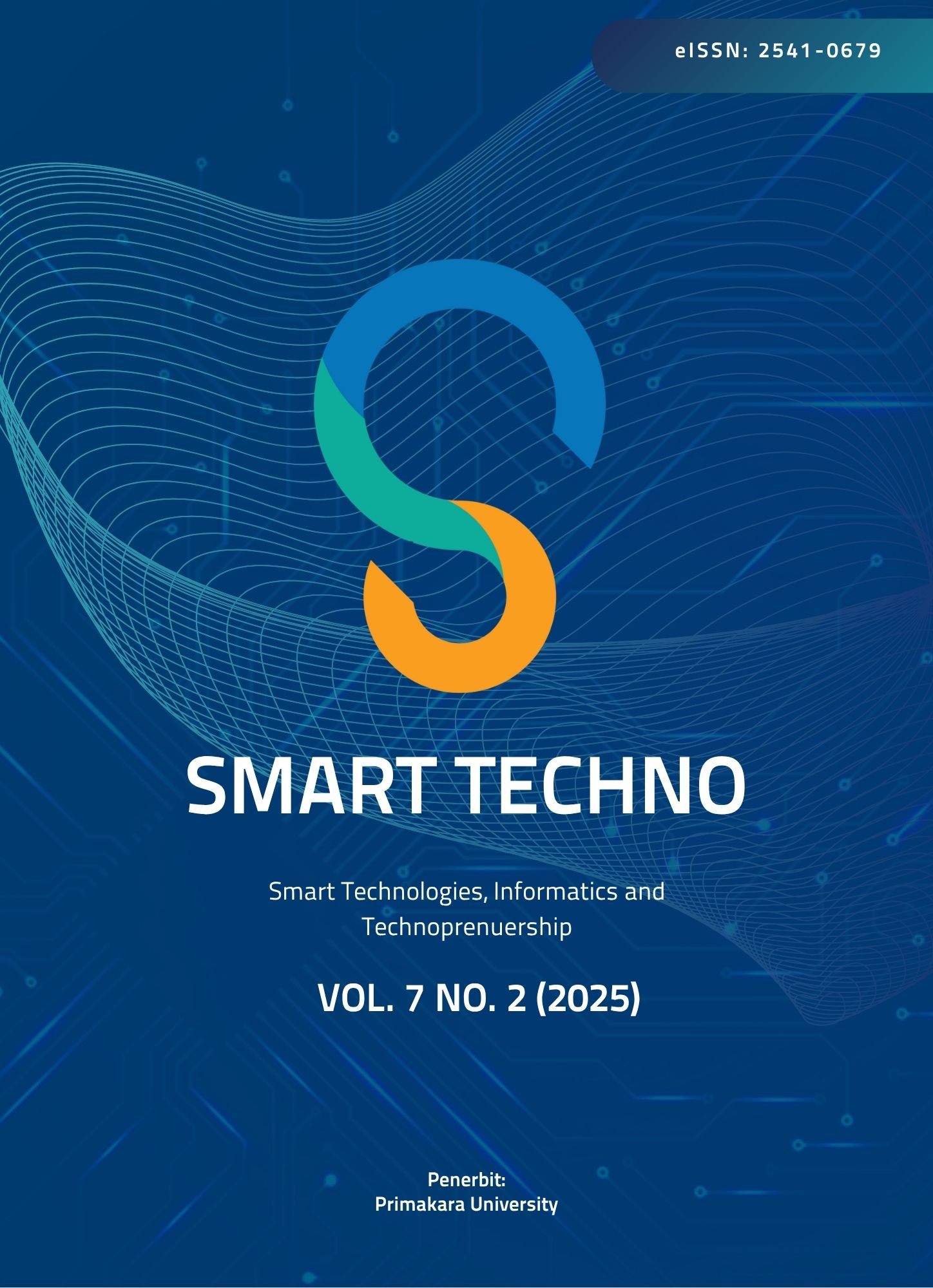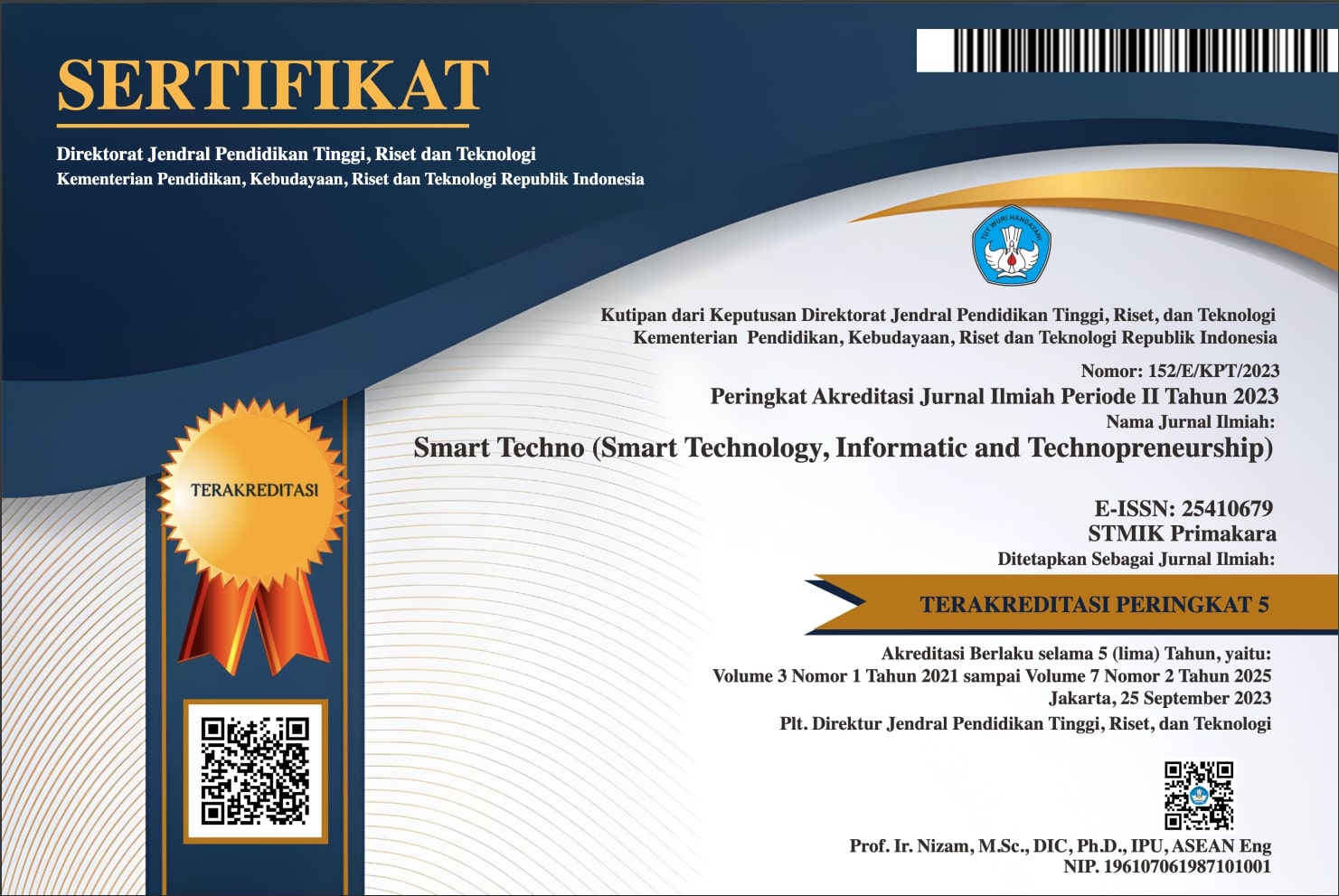Predicting Crop Water Requirements Using IoT Sensor Data for Deep Learning
Abstract
Optimasi irigasi merupakan faktor krusial dalam meningkatkan produktivitas pertanian dan efisiensi penggunaan sumber daya air. Penelitian ini mengusulkan pendekatan berbasis deep learning untuk memprediksi kebutuhan air tanaman menggunakan data dari sensor IoT. Sistem ini mengumpulkan parameter lingkungan secara real-time, seperti kelembaban tanah, suhu, kelembaban udara, dan radiasi matahari, yang kemudian diproses menggunakan model deep learning untuk menghasilkan rekomendasi irigasi yang akurat. Model dilatih dan dievaluasi menggunakan data historis sensor guna memastikan keandalan dalam berbagai kondisi iklim. Metode yang diusulkan bertujuan untuk meminimalkan pemborosan air sekaligus menjaga kadar kelembaban tanah yang optimal, sehingga meningkatkan kesehatan tanaman dan hasil panen. Hasil eksperimen menunjukkan bahwa model deep learning memiliki akurasi prediksi yang lebih baik dibandingkan dengan sistem irigasi berbasis ambang batas konvensional. Penelitian ini berkontribusi pada pengembangan pertanian cerdas dengan mengintegrasikan teknologi IoT dan kecerdasan buatan untuk pertanian presisi.
Downloads
References
[2] J. Huang, S. Fatichi, G. Mascaro, G. Manoli, and N. Peleg, “Intensification of sub-daily rainfall extremes in a low-rise urban area,” Urban Clim., vol. 42, p. 101124, Mar. 2022, doi: https://doi.org/10.1016/j.uclim.2022.101124.
[3] G. Guardia, D. Abalos, N. Mateo-Marín, D. Nair, and S. O. Petersen, “Using DMPP with cattle manure can mitigate yield-scaled global warming potential under low rainfall conditions,” Environ. Pollut., vol. 316, p. 120679, Jan. 2023, doi: https://doi.org/10.1016/j.envpol.2022.120679.
[4] C.-X. Yang, L. M. Baker, A. Mattox, D. Diehl, and S. Honeycutt, “The forgotten factor: Exploring consumer perceptions of artificial intelligence in the food and agriculture systems,” Futur. Foods, vol. 11, p. 100553, Jun. 2025, doi: https://doi.org/10.1016/j.fufo.2025.100553.
[5] A. Rahman, “Penyiraman Tanaman Secara Otomatis Menggunakan Propeler berbasis IoT,” ITEJ (Information Technol. Eng. Journals), vol. 3, no. 2, pp. 20–27, Dec. 2018, doi: https://doi.org/10.24235/itej.v3i2.29.
[6] N. N. Thilakarathne, M. S. Abu Bakar, P. E. Abas, and H. Yassin, “Internet of things enabled smart agriculture: Current status, latest advancements, challenges and countermeasures,” Heliyon, vol. 11, no. 3, p. e42136, Feb. 2025, doi: https://doi.org/10.1016/j.heliyon.2025.e42136.
[7] P. Sankarasubramanian, “Enhancing precision in agriculture: A smart predictive model for optimal sensor selection through IoT integration,” Smart Agric. Technol., vol. 10, p. 100749, Mar. 2025, doi: https://doi.org/10.1016/j.atech.2024.100749.
[8] M. Li et al., “Optimization of agricultural planting structure in irrigation areas of Heilongjiang province considering the constraints of water resource system resilience,” J. Clean. Prod., vol. 434, p. 140329, Jan. 2024, doi: https://doi.org/10.1016/j.jclepro.2023.140329.
[9] A. Hadir, M. Adjou, O. Assainova, G. Palka, and M. Elbouz, “Comparative Study of Agricultural Parcel Delineation Deep Learning Methods using Satellite Images: Validation through Parcels Complexity,” Smart Agric. Technol., p. 100833, Feb. 2025, doi: https://doi.org/10.1016/j.atech.2025.100833.
[10] V. Choudhary, P. Guha, G. Pau, and S. Mishra, “An overview of smart agriculture using internet of things (IoT) and web services,” Environ. Sustain. Indic., vol. 26, p. 100607, Jun. 2025, doi: https://doi.org/10.1016/j.indic.2025.100607.
[11] A. Morchid, Z. Oughannou, R. El Alami, H. Qjidaa, M. O. Jamil, and H. M. Khalid, “Integrated internet of things (IoT) solutions for early fire detection in smart agriculture,” Results Eng., vol. 24, p. 103392, Dec. 2024, doi: https://doi.org/10.1016/j.rineng.2024.103392.
[12] A. Morchid, R. El Alami, A. A. Raezah, and Y. Sabbar, “Applications of internet of things (IoT) and sensors technology to increase food security and agricultural Sustainability: Benefits and challenges,” Ain Shams Eng. J., vol. 15, no. 3, p. 102509, Mar. 2024, doi: https://doi.org/10.1016/j.asej.2023.102509.
[13] S. P. Nayak, S. C. Rai, and B. Sahoo, “SAW: A real-time surveillance system at an agricultural warehouse using IoT,” in AI, Edge and IoT-based Smart Agriculture, Elsevier, 2022, pp. 315–327.
[14] A. Morchid et al., “IoT-enabled smart agriculture for improving water management: A smart irrigation control using embedded systems and Server-Sent Events,” Sci. African, vol. 27, p. e02527, Mar. 2025, doi: https://doi.org/10.1016/j.sciaf.2024.e02527.
[15] S. R. Abd Shukor, N. A. Rosli, M. Mohd Nadzir, F. N. Gonawan, and A. F. Noor Hishamuddin, “Process Design and Optimization of Agricultural Waste Resources to Biomethanol,” in Reference Module in Chemistry, Molecular Sciences and Chemical Engineering, Elsevier, 2024.
[16] E. H. Lee, “Groundwater level prediction using modified recurrent neural network combined with meta-heuristic optimization algorithm,” Groundw. Sustain. Dev., vol. 28, p. 101398, Feb. 2025, doi: https://doi.org/10.1016/j.gsd.2024.101398.
[17] R. Lu, Y. Zhang, Q. Huang, P. Zeng, Z. Shi, and S. Ye, “A refined edge-aware convolutional neural networks for agricultural parcel delineation,” Int. J. Appl. Earth Obs. Geoinf., vol. 133, p. 104084, Sep. 2024, doi: https://doi.org/10.1016/j.jag.2024.104084.
[18] A. Kosari-Moghaddam et al., “China’s climate change mitigation and adaptation strategies for decreasing environmental impacts in the agricultural sector,” Sustain. Prod. Consum., vol. 53, pp. 147–161, Jan. 2025, doi: https://doi.org/10.1016/j.spc.2024.12.006.
[19] L. Preite and G. Vignali, “Artificial intelligence to optimize water consumption in agriculture: A predictive algorithm-based irrigation management system,” Comput. Electron. Agric., vol. 223, p. 109126, Aug. 2024, doi: https://doi.org/10.1016/j.compag.2024.109126.
[20] A. Sharma et al., “IoT and deep learning-inspired multi-model framework for monitoring Active Fire Locations in Agricultural Activities,” Comput. Electr. Eng., vol. 93, p. 107216, Jul. 2021, doi: https://doi.org/10.1016/j.compeleceng.2021.107216.
[21] D. Sahoo, P. Mohanty, S. Mishra, M. K. Behera, and S. Mohapatra, “Does climate-smart agriculture technology improve farmers’ subjective well-being? Micro-level evidence from Odisha, India,” Farming Syst., vol. 3, no. 1, p. 100124, Jan. 2025, doi: https://doi.org/10.1016/j.farsys.2024.100124.
[22] D. Uztürk and G. Büyüközkan, “Industry 4.0 technologies in Smart Agriculture: A review and a Technology Assessment Model proposition,” Technol. Forecast. Soc. Change, vol. 208, p. 123640, Nov. 2024, doi: https://doi.org/10.1016/j.techfore.2024.123640.
[23] V. Kumar, K. V. Sharma, N. Kedam, A. Patel, T. R. Kate, and U. Rathnayake, “A comprehensive review on smart and sustainable agriculture using IoT technologies,” Smart Agric. Technol., vol. 8, p. 100487, Aug. 2024, doi: https://doi.org/10.1016/j.atech.2024.100487.
[24] A. Çifci, İ. Kırbaş, and O. T. Bişkin, “Computational analysis of recurrent neural network models for precipitation forecasting: a case study in Burdur, Türkiye,” in Computational Modeling Applications for Climate Crisis, Elsevier, 2025, pp. 15–32.
[25] J. Zhang, Y. Zhu, X. Zhang, M. Ye, and J. Yang, “Developing a Long Short-Term Memory (LSTM) based model for predicting water table depth in agricultural areas,” J. Hydrol., vol. 561, pp. 918–929, Jun. 2018, doi: https://doi.org/10.1016/j.jhydrol.2018.04.065.
[26] L. V. Bautista-Romero, J. D. Sánchez-Murcia, and J. G. Ramírez-Gil, “Data science for pattern recognition in agricultural large time series data: A case study on sugarcane sucrose yield,” Heliyon, vol. 11, no. 4, p. e42632, Feb. 2025, doi: https://doi.org/10.1016/j.heliyon.2025.e42632.
[27] C. Lv et al., “Soil moisture retrieval over agricultural fields with machine learning: A comparison of quad-, compact-, and dual-polarimetric time-series SAR data,” J. Hydrol., vol. 644, p. 132093, Nov. 2024, doi: https://doi.org/10.1016/j.jhydrol.2024.132093.
[28] M. Rahman et al., “Integrating deep learning algorithms for forecasting evapotranspiration and assessing crop water stress in agricultural water management,” J. Environ. Manage., vol. 375, p. 124363, Feb. 2025, doi: https://doi.org/10.1016/j.jenvman.2025.124363.
[29] A. Peeters et al., “A spatial machine-learning model for predicting crop water stress index for precision irrigation of vineyards,” Comput. Electron. Agric., vol. 227, p. 109578, Dec. 2024, doi: https://doi.org/10.1016/j.compag.2024.109578.
[30] B. Alwar, H. Edgardo, and E. Faustino, “Integrating IoT and Artificial Intelligence for Sustainable Smart City Development: A Case Study Approach,” ITEJ (Information Technol. Eng. Journals), vol. 9, no. 2, pp. 80–90, Dec. 2024, doi: https://doi.org/10.24235/itej.v9i2.137.
Copyright (c) 2025 Saluky Saluky, Aisya Fatimah

This work is licensed under a Creative Commons Attribution 4.0 International License.
Authors who publish with the Smart Techno agree to the following terms:
- Authors retain copyright and grant the journal the right of first publication with the work simultaneously licensed under a Creative Commons Attribution License (CC BY-SA 4.0) that allows others to share the work with an acknowledgment of the work's authorship and initial publication in this journal.
- Authors are able to enter into separate, additional contractual arrangements for the non-exclusive distribution of the journal's published version of the work (e.g., post it to an institutional repository or publish it in a book), with an acknowledgment of its initial publication in this journal.
- Authors are permitted and encouraged to post their work online (e.g., in institutional repositories or on their website) prior to and during the submission process, as it can lead to productive exchanges, as well as earlier and greater citation of published work. (See The Effect of Open Access)







